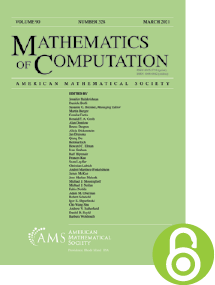Note on representing a prime as a sum of two squares
HTML articles powered by AMS MathViewer
- by John Brillhart PDF
- Math. Comp. 26 (1972), 1011-1013 Request permission
Abstract:
An improvement is given to the method of Hermite for finding $a$ and $b$ in $p = {a^2} + {b^2}$, where $p$ is a ${\text {prime}} \equiv 1\pmod 4$.References
-
C. Hermite, “Note au sujet de l’article précédent,” J. Math. Pures Appl., v. 1848, p. 15; also: “Note sur un théorème rélatif aux nombres entières,” Oevres. Vol. 1, p. 264.
- D. H. Lehmer, Computer technology applied to the theory of numbers, Studies in Number Theory, Math. Assoc. America, Buffalo, N.Y.; distributed by Prentice-Hall, Englewood Cliffs, N.J., 1969, pp. 117–151. MR 0246815
- Oskar Perron, Die Lehre von den Kettenbrüchen, Chelsea Publishing Co., New York, N. Y., 1950 (German). 2d ed. MR 0037384 J. A. Serret, “Sur un théorème rélatif aux nombres entières,” J. Math. Pures Appl., v. 1848, pp. 12-14. D. Shanks, Review of “A table of Gaussian primes,” by L. G. Diehl and J. H. Jordan, Math. Comp., v. 21, 1967, pp. 260-262.
Additional Information
- © Copyright 1972 American Mathematical Society
- Journal: Math. Comp. 26 (1972), 1011-1013
- MSC: Primary 10A25; Secondary 10A30
- DOI: https://doi.org/10.1090/S0025-5718-1972-0314745-6
- MathSciNet review: 0314745


